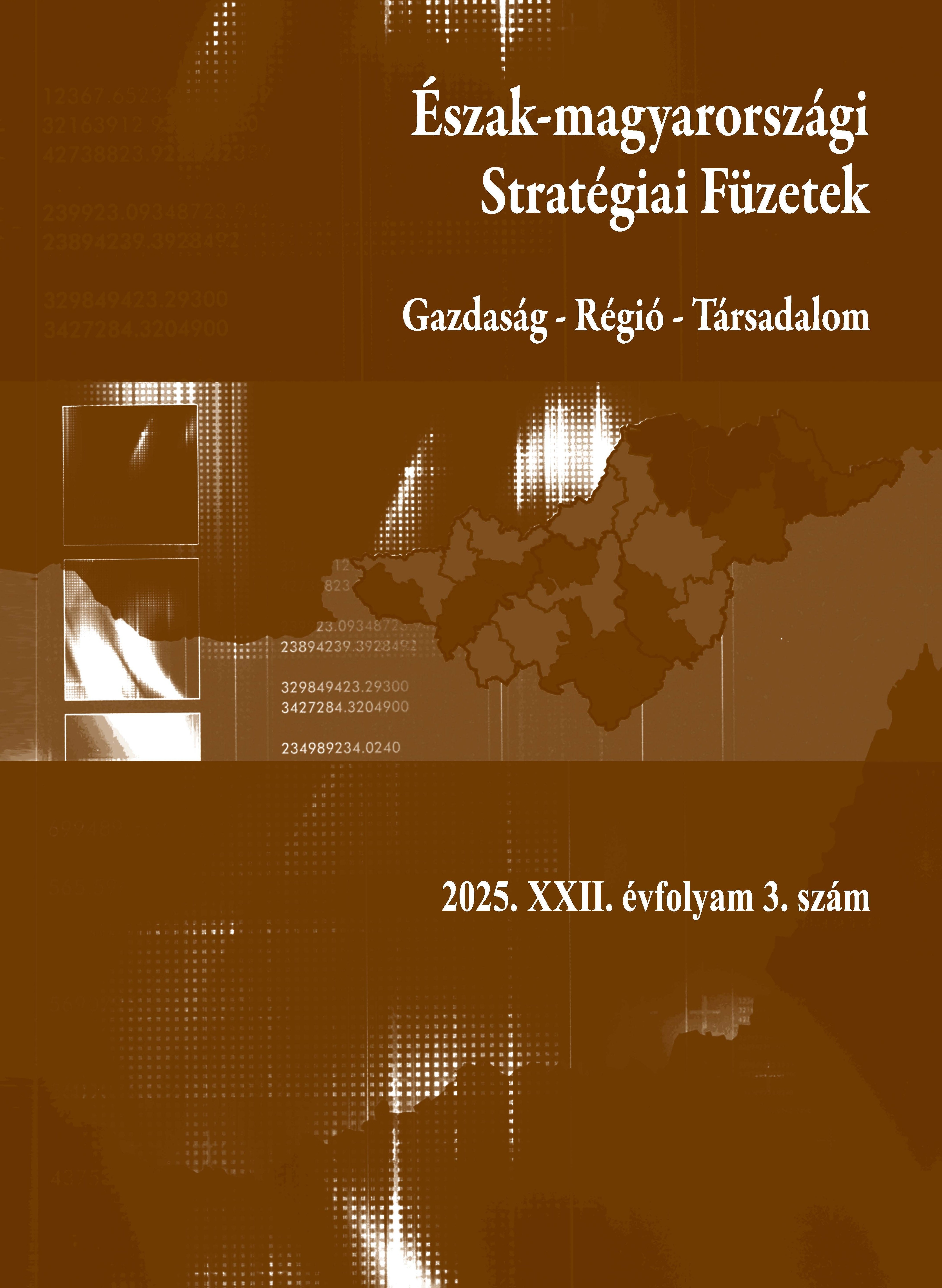What does the carbon footprint of a central university building say to management?
DOI:
https://doi.org/10.32976/stratfuz.2025.26Keywords:
carbon dioxide emission, carbon footprint, higher education institution, sustainability management, Bilan CarbonAbstract
This paper examines the carbon footprint of a multifunctional central university building, the József Attila Study and Information Centre (SZTE TIK). The aim is to identify key sources of environmental impact and propose recommendations for institutional strategy development. The study uses the Bilan Carbone calculator to analyze one full year of operational data, including direct emissions, purchased energy, and commuting habits of staff and visitors, assessed via survey. The results are compared with international benchmarks from other higher education institutions. Findings reveal that nearly 50% of the carbon footprint derives from energy use, while procurement-related emissions slightly exceed this. Although staff car use generates more CO₂ per capita than student travel, the student population contributes a much larger aggregate impact due to scale. Visitor commuting alone accounts for 95% of total travel emissions. Compared to similar institutions, SZTE TIK shows higher carbon intensity, potentially due to broader data scope or more energy-intensive operations. The study emphasizes targeting fossil fuel and electricity consumption as high-impact mitigation areas.
Our results suggest that the resources available to reduce carbon emissions should be used to reduce fossil fuel use and electricity consumption. In terms of environmental pressures from student commuting, it is essential to encourage the spread of sustainable mobility options and to support university communities that promote sustainable practices.
References
ALVAREZ, S., BLANQUER, M., & RUBIO, A. (2014). Carbon footprint using the compound method based on financial accounts: The case of the School of Forestry Engineering, Technical University of Madrid. Journal of Cleaner Production, 66, 224-232. https://doi.org/10.1016/j.jclepro.2013.11.050
DOWNIE, J., & STUBBS, W. (2012). Corporate carbon strategies and greenhouse gas emission assessments: The implications of Scope 3 emission factor selection. Business Strategy and the Environment, 21(6), 412-422. https://doi.org/10.1002/bse.1734
FENNER, A. E., KIBERT, C. J., WOO, J., MORQUE, S., RAKENARI, M., HAKIM, H., & LU, X. (2018). The carbon footprint of buildings: A review of methodologies and applications. Renewable and Sustainable Energy Reviews, 94, 1142-1152. https://doi.org/10.1016/j.rser.2018.07.012
HARANGOZÓ, G., SZÉCHY, A. ZS., & ZILAHY, GY. (2016). A fenntarthatósági lábnyom-megközelítések szerepe a vállalatok fenntarthatósági szempontú teljesítményértékelésben. Vezetéstudomány, 47(7), 2-13. https://doi.org/10.14267/VEZTUD.2016.07.01
HARANGOZÓ, G., & SZIGETI, C. (2017). Corporate carbon footprint analysis in practice – with a special focus on validity and reliability issues. Journal of Cleaner Production, 167, 1177-1183. https://doi.org/10.1016/j.jclepro.2017.07.237
HUBERT, J. (2023). „Kérem, gondoljon a környezetre, mielőtt kinyomtatja ezt a cikket!” – A belső marketing szerepe a szervezetek környezetvédelmi erőfeszítéseinek közvetítésében és hatása a fiatal munkavállalók elégedettségére. Marketing & Menedzsment, 57(3), 58-67. https://doi.org/10.15170/MM.2023.57.03.06
IDUNDUN, E., HURSTHOUSE, A. S., & MCLELLAN, I. (2021). Carbon management in UK higher education institutions: An overview. Sustainability, 13(19), 10896. https://doi.org/10.3390/su131910896
INTERGOVERNMENTAL PANEL ON CLIMA CHANGE (n.d.). https://www.ipcc.ch/
JAKOPÁNECZ, E., NEULINGER, Á., LÁNYI, B., & CSÓKA, L. (2024). Környezettudatos fogyasztás a tömegessé válás útján: Nemzetközi és hazai tapasztalatok. Marketing & Menedzsment, 57(4), 5-14. https://doi.org/10.15170/MM.2023.57.04.01
LI, Y., & JIA, Q.-S. (2022). On the feasibility to achieve carbon neutrality in university campus: A case study. IFAC-PapersOnLine, 55(5), 78-83. https://doi.org/10.1016/j.ifacol.2022.07.643
LO-IACONO, V., TORREGROSA, J., & CAPUZ, S. (2018). The use of carbon footprint as a key performance indicator in higher education institutions. Proceedings of the 22nd International Congress on Project Management and Engineering, Madrid, Spain, 11-13 July 2018.
MATTHEWS, H. S., HENDRICKSON, C. T., & WEBER, C. L. (2008). The importance of carbon footprint estimation boundaries. Environmental Science & Technology Viewpoint, 42, 5839-5842. https://doi.org/10.1021/es703112w
MARR, B. (2012). Key performance indicators (KPI): The 75 measures every manager needs to know. Pearson UK.
NAGY, SZ. (2023). Az egyetemi fenntarthatóság hallgatói észlelésének mérése. Marketing & Menedzsment, 57(Különszám EMOK 2), 35-44. https://doi.org/10.15170/MM.2023.57.KSZ.02.04
NAGY, SZ., MOLNÁR, L., & HAJDÚ, N. (2024). A megújuló energiaforrások használatával kapcsolatos felhasználói magatartás elemzése. Marketing & Menedzsment, 58(3), 25-36.https://doi.org/10.15170/MM.2024.58.03.03
NEULINGER, A., NAGY, J. M., PETRÓCZI, ZS., KISS, G., VERESS, T., & LAZÁNYI, O. (2023). Hogyan támogathatja a közösség a fenntarthatóbb életmódot? Egy részvételi kutatás tapasztalatai. Marketing & Menedzsment, 57(1), 15-24. https://doi.org/10.15170/MM.2023.57.01.02
PAREDES-CANENCIO, K. N., LASSO, A., CASTRILLON, R., VIDAL-MEDINA, R. J., & QUISPE, C. E. (2024). Carbon footprint of higher education institutions. Environment, Development and Sustainability, 26, 30239-30272. https://doi.org/10.1007/s10668-024-04596-4
PELLETIER, P., ALLASKE, R. K., PANT, R., & MANFREDI, S. (2014). The European Commission organisation environmental footprint method: Comparison with other methods, and rationales for key requirements. The International Journal of Life Cycle Assessment, 19(2), 387-404. https://doi.org/10.1007/s11367-013-0609-x
SCHAEFER, F., & BLANKE, M. (2014). Opportunities and challenges of carbon footprint, climate or CO2 labelling for horticultural products. Erwerbs-Obstbau, 56, 73-80. https://doi.org/10.1007/s10341-014-0206-6
SZIGETI, C., SZENNAY, Á., LISÁNYI ENDRÉNÉ, B. J., POLÁK-WELLDON, R., & RADÁCSI, L. (2019). Vállalati ökológiailábnyom-számítás kihívásai a KKV-szektorban. Vezetéstudomány, 50(7-8), 63-69. https://doi.org/10.14267/VEZTUD.2019.07.06
TRAN, A. T. (2013). Making an inventory of greenhouse gas emission in Hue City using the Bilan Carbone method. Journal of Science, Hue University, 84(6), 75-81.
UNITED NATIONS ENVIRONMENT PROGRAMME. (2009). Common carbon metric for measuring energy use and reporting greenhouse gas emissions from building operations. https://wedocs.unep.org/20.500.11822/7922
UNITED NATIONS. (1998). Kyoto Protocol to the United Nations Framework Convention on Climate Change. https://unfccc.int/resource/docs/convkp/kpeng.pdf
UNITED NATIONS. (2015). Paris Agreement. https://unfccc.int/sites/default/files/english_paris_agreement.pdf
VALLS-VAL, K., & BOVEA, M. D. (2021). Carbon footprint in higher education institutions: A literature review and prospects for future research. Clean Technologies and Environmental Policy, 23, 2523-2542. https://doi.org/10.1007/s10098-021-02180-2
WACKERNAGEL, M., & REES, W. (1996). Our ecological footprint: Reducing human impact on the Earth. Philadelphia, PA: New Society. https://doi.org/10.5070/G31710273
WIEDMANN, T., & MINX, J. (2007). A definition of “carbon footprint”. Ecological Economics Research Trends, 1-11.
ŽELJKO, J., & LJUBAS, D. (2020). Comparative assessment of carbon footprints of selected organizations: The application of the enhanced Bilan Carbone model. Sustainability, 12(22), 1-18. https://doi.org/10.3390/su12229618
Downloads
Published
How to Cite
Issue
Section
License

This work is licensed under a Creative Commons Attribution-NonCommercial-NoDerivatives 4.0 International License.







